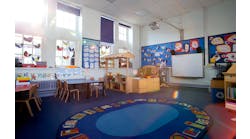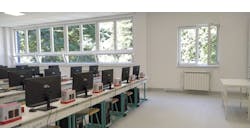Daylighting a space is both an art and a science. The impact of daylight can make a building's design come to life. Daylighting can be carried out skillfully, or it can be too casually considered or totally misunderstood. Bad daylighting is devastating to a space and costly to fix. Today, in this era of sustainable design, daylighting is given more consideration than ever.
One of the desirable attributes of daylighting is its significant role in creating the mood or atmosphere of a space. It affects the comfort, productivity, performance, health and well-being of occupants. Daylighting has a significant influence on energy efficiency, electrical lighting costs and HVAC climate control. And of course, the green movement and desirability of earning LEED points increasingly inform the daylighting plans for buildings.
Too often, designers don't comprehend the result of a daylight scheme until construction is completed, the space occupied, and all the money spent. This is the wrong time to discover glare, over-bright areas, shadows, dark spaces or poorly balanced light levels. Effective daylighting, one of the most powerful tools available to architects, should be planned in the design phase.
Simulated results
Just as traditional miniature, scale-model building and 3-D computer modeling help represent what a finished design will look like, climate-based daylight simulation demonstrates clearly the impact of the size, type and placement of skylights, windows or translucent wall systems. Results can be compared and changes made in the early design stages before final recommendations are made. Using computer-generated charts and light-level schematics, daylight modeling simulates the effects of daylighting and enables designers to analyze the behavior of light within the space.
Well-planned daylighting considers significant circumstances beyond the confines of a building. How is the structure to be positioned on a site relative to the lay of the land or the points of the compass? Local climate and seasonality of the sun's path should be simulated, along with the surrounding topography. Are there mountains or trees nearby, or reflections off the surfaces of buildings or bodies of water? Nearby structures might create an urban canyon on the site during certain hours of the day or times of the year.
Effective daylighting cannot be rubber-stamped from one building to the next. A daylighting design that is effective in one location simply may not be in another. How much daylight does it take to provide the desired results? What about harsh glare and shadows?
Who has not observed a space, such as a restaurant, waiting room, manufacturing area, retail space or classroom, where bright sunlight from time to time blinds occupants, overheats the space or overworks the HVAC system? Unmitigated sunlight often ruins a daylighting design. Controlling quality and quantity of daylight is imperative to managing related heat loss/gain and overall comfort.
Using daylight modeling, "what if" scenarios can be considered and demonstrated; pre-planning can manage and eliminate all of the negatives. Alternative design solutions can be studied and planned. Spaces can be analyzed for a certain time of day or season, as solar angles change, or evaluated for overall annual performance using local climate conditions. Daylight modeling shows the way to better illuminate any space and eliminates costly design mistakes.
- Read the "Light evaluation" sidebar to learn about the steps in designing a space.
Gleed is a principal of Kalwall Corp., Manchester, N.H., and serves on several technical committees of the Illuminating Engineering Society of North America (IESNA). She can be reached at [email protected].
Light evaluation
One of the first steps in designing a space is to evaluate the effect of direct beams of sunlight. In educational settings, such as classrooms or libraries, balanced daylighting is essential for ambient light levels.
Figure 1 shows an example of a design submitted for daylight simulation. The architect asked for help in selecting light transmittance for the skylights. The model was run with different glazing options, and it provided the designer with information to help meet the target luminance for the space below.
First to be assessed was the skylight at noon on the equinox (Sept 21st); the sun is overhead where it is strongest and gives a good indication of typical light levels midday in the space for most of the year (noon in summer months is higher as the solar angle is more direct; winter months have a lower sun angle at noon). Using 30 percent glass for the skylight results in uneven light levels, as direct sunlight is not controlled. Shown here is a false-color plan view, which reveals excessive areas of direct sun (shown in bright yellow); light levels are not balanced within the space. This highlights the glare problem caused by sunlight coming through the glass.
An alternate toplighting strategy then was considered, changing to translucent sandwich panels to manage the direct beam penetration. This analysis is based on 8 percent light transmittance. Figure 2 shows the new plan view for the same space. Given the same sky condition, the translucent sandwich panels diffuse direct sunlight to fill the entire space evenly with controlled, balanced daylight.
Had the original plans been executed, the results would have been disappointing. Students and staff would have had difficulty dealing with imbalanced light levels and glare. Thanks to daylight simulation, alternatives were considered and decisions made that resulted in a more effective design and a more comfortable space. Balanced daylighting also will generate operational savings through reduced HVAC loads and electric consumption.

